This isn’t just any normal salsa; it’s the best fermented salsa. A probiotic powerhouse salsa with live cultures and the most amazing flavor!
You don’t need any fermentation experience to make this easy recipe. My recipe uses a quick ferment process (ready in a couple days) and requires no special equipment. Made with fresh tomatoes, garlic, onions, cilantro, salt, and lime juice.
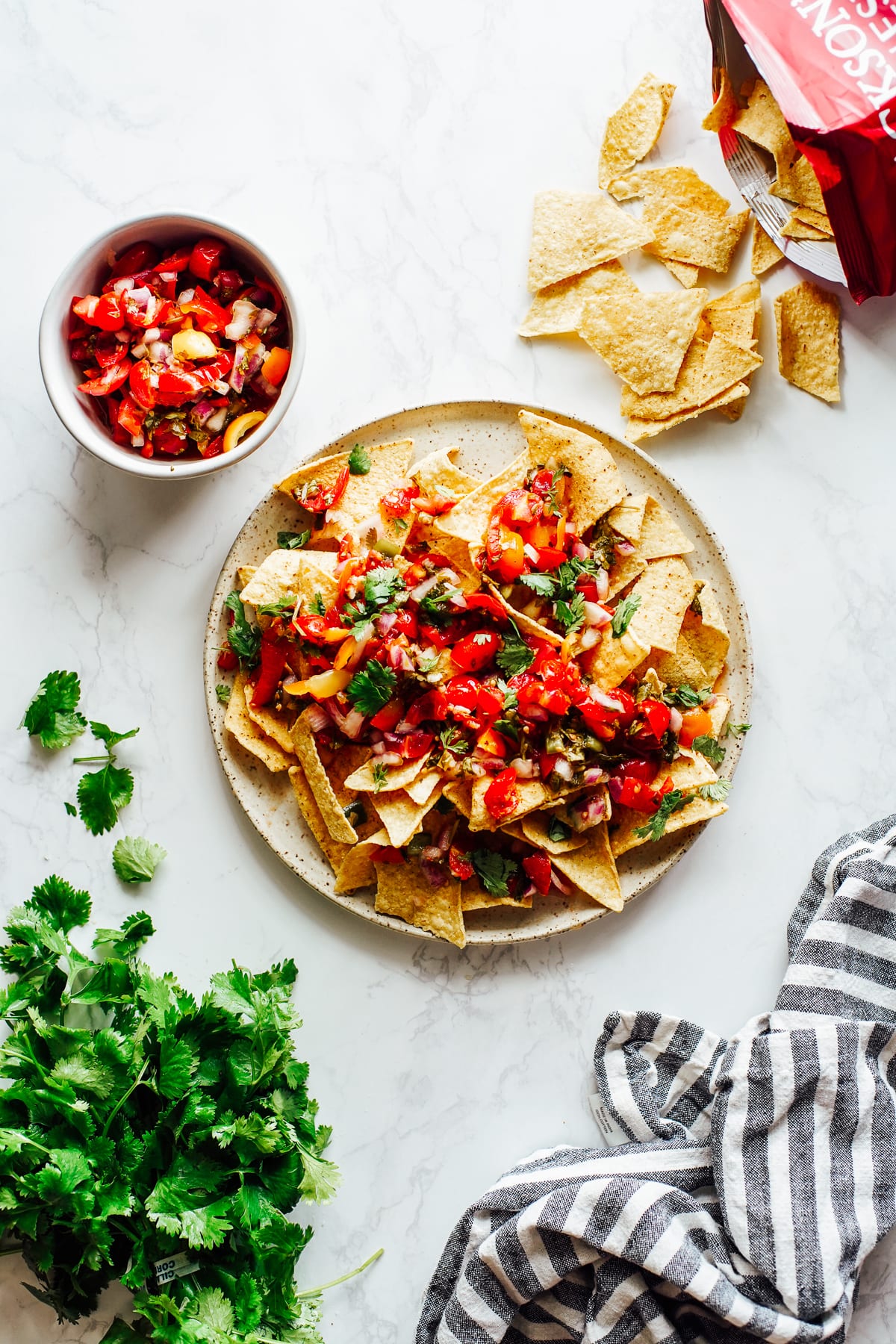
Want to Save This Recipe?
Enter your email & I’ll send it straight to your inbox. And you’ll get new recipes & tips each week.
Fermentation 101
A few months ago, Sarah from St. Pete Ferments joined me on the podcast to talk about fermentation. In the podcast episode, Sarah shares why consuming fermented food is important, particularly ferments that are made in your local area. You can listen to the episode below.
Since this chat, I have a renewed interest in making homemade ferments in my own kitchen and buying ferments from the local farmers market. Not only for the health benefits (hello, good bacteria) but also their amazing taste. I’ve made sourdough on and off over the years and just recently started making my own sauerkraut and now our favorite salsa.
What is a Lacto-Fermented Salsa Recipe?
- This salsa uses the lacto fermentation method.
- Lacto-fermentation is the most popular and traditional fermentation method used to preserve dairy products (like yogurt), meat (cured meats like prosciutto and salami), and vegetables (like pickles and homemade sauerkraut).
- Fresh vegetables are naturally covered in lactic-acid bacteria, so when the veggies are submerged in a salted brine, the good lactic-acid-producing bacteria naturally begins to ferment the food.
- Fermentation is the breakdown of sugars, by the enzymes of microorganisms, that turn into natural yeast and bacterial growth when oxygen isn’t present.
- Lacto fermented salsa is simply homemade salsa that rests at room temperature for a couple of days, resulting in a bacteria-rich, preserved food.
Now, I know what you’re probably thinking, “Wait, but won’t bad bacteria take over and produce awful, rotten salsa?” Let’s talk about that…
Salt is added to the initial fermentation of the salsa to prevent the bad bacteria from growing before the good guys get to work on populating the salsa mixture. So there’s no need to worry. Fermentation is a very natural and beautiful process.
I know it sounds scary, but it’s not. People have been fermenting foods, an effective food preservation method, for thousands of years.
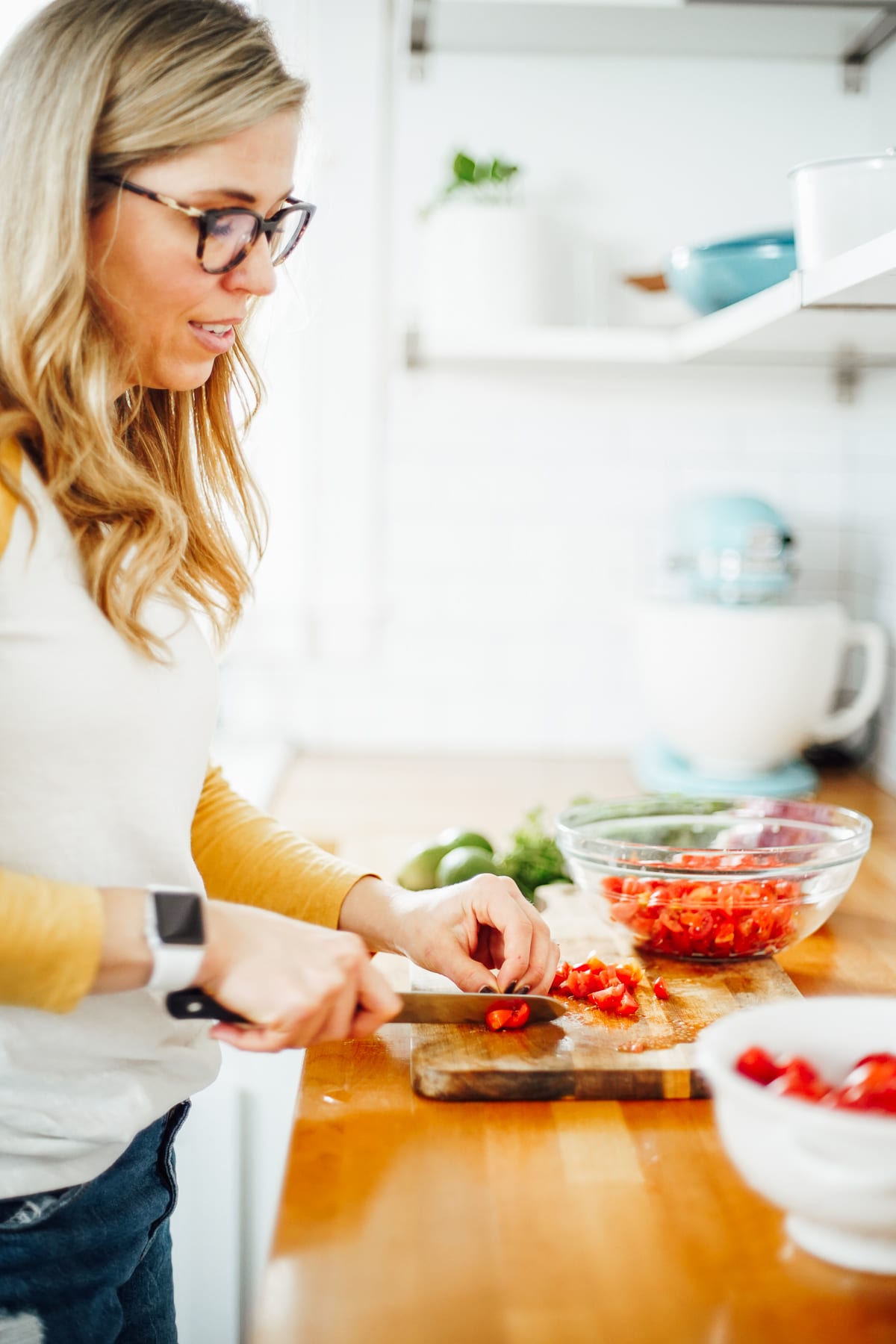
Salsa Ingredients
- 2 lbs of tomatoes (cherry or grape tomatoes work best), chopped
- 6 garlic cloves, minced
- 1-2 hot peppers, such as: jalapeno pepper, poblano pepper, or serrano pepper, chopped (all based on personal taste; the fermentation process mellows the pepper taste so you won’t end up with a super spicy salsa)
- 2 fresh cilantro bunches, chopped
- 1 medium red onion or yellow onion, chopped (about 1-2 cups once chopped, depending on taste preference)
- 2 limes, juiced
- 1 tablespoon fine salt
Tools Needed
- 1 large bowl for mixing the ingredients together
- 2 liter tall glass jar with an air-tight lid (such as a mason jar) OR a fermentation jar with fermentation lid
- 1 weight to weigh down the vegetables and submerge them under the surface of the liquid (weight examples: half a bell pepper, cabbage leaf, half an onion, a clean stone, or fermentation weight)
Time-Saving Tip: Use a food processor or blender to chop the tomatoes, garlic, pepper, and cilantro. Pulse the vegetables a few times (don’t blend non-stop) until chopped. This will make for a more blended (less chunky) salsa, too.
How to Make the Best Salsa (Instructions & Photos)

The Easy Process: Making fermented salsa is a super easy process (perfect for first time fermenters). If you can chop tomatoes and onions, and mince garlic, you can ferment salsa. You don’t need any special fermentation tools, a culture or whey, or prior fermentation experience. Below, you’ll find full instructions and photos to guide you.
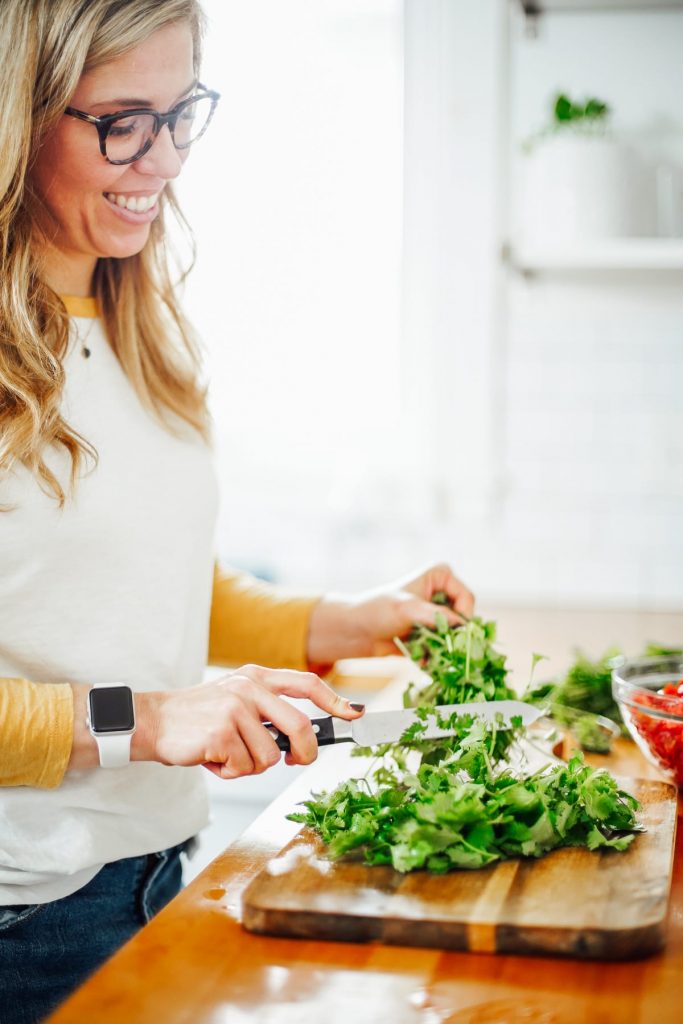
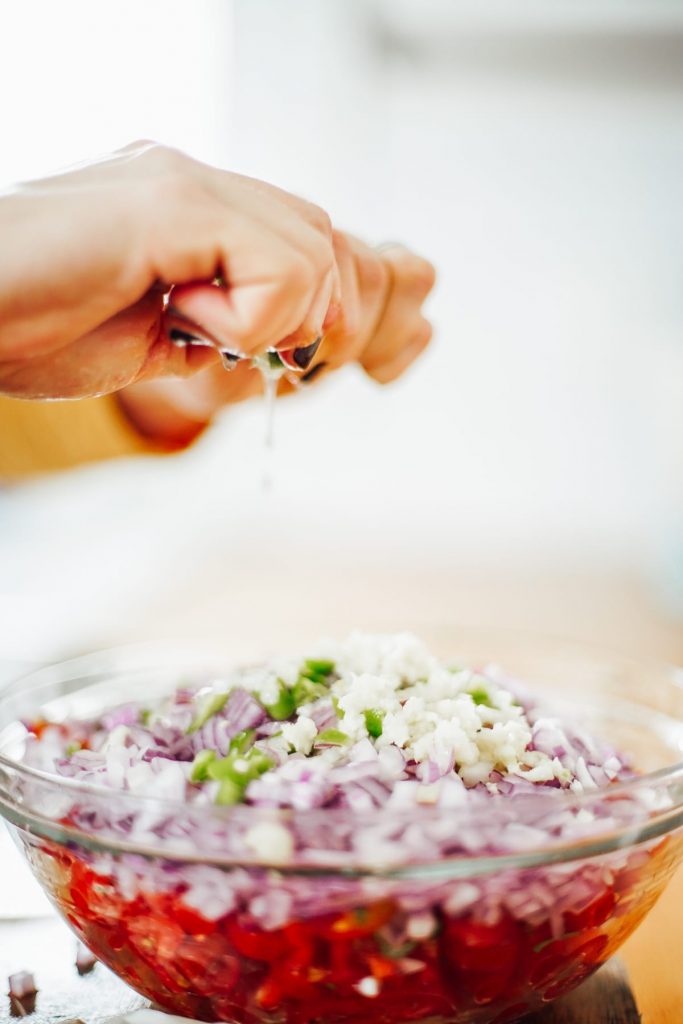
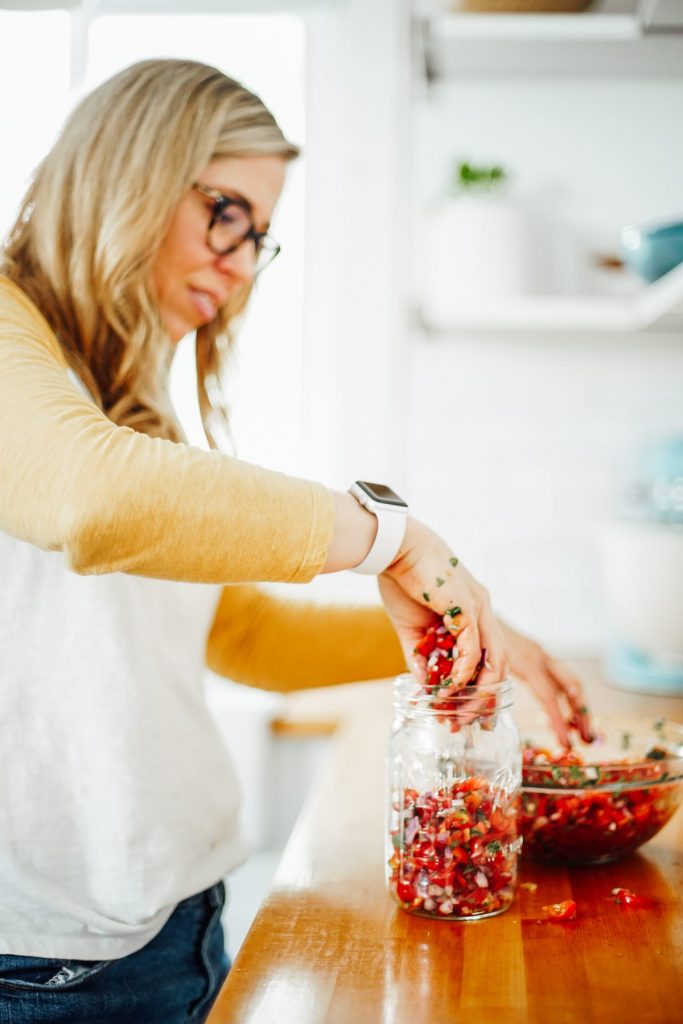
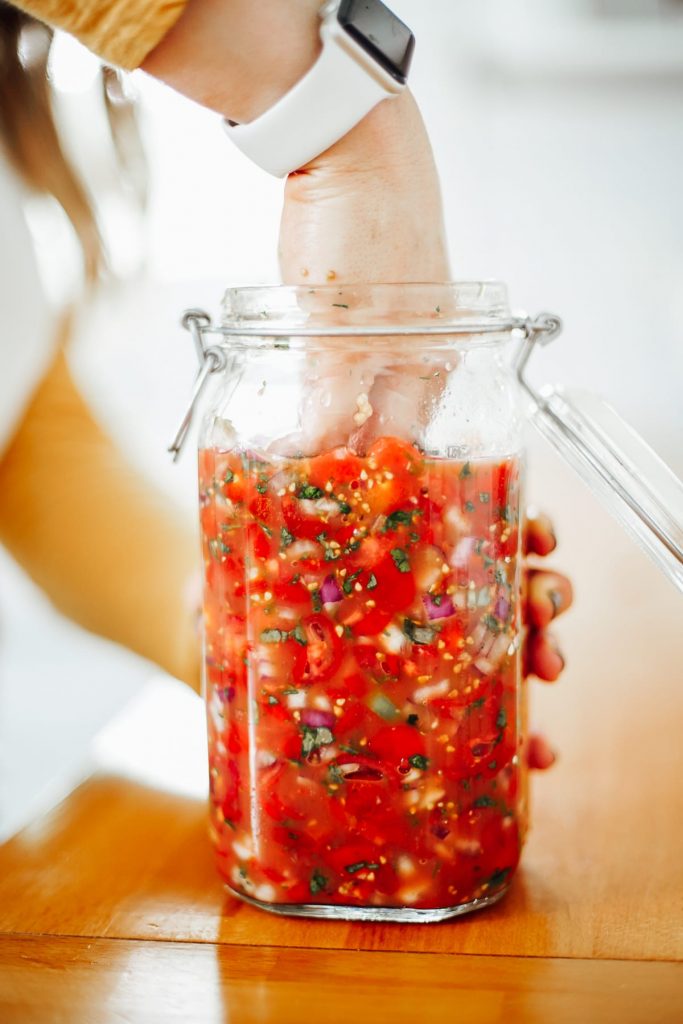
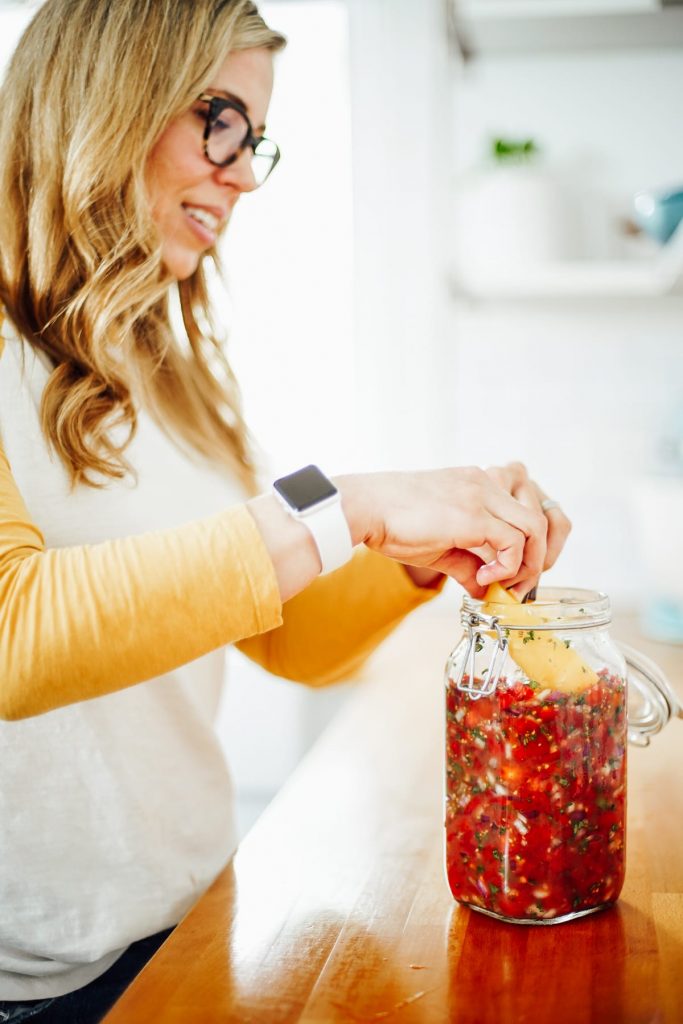
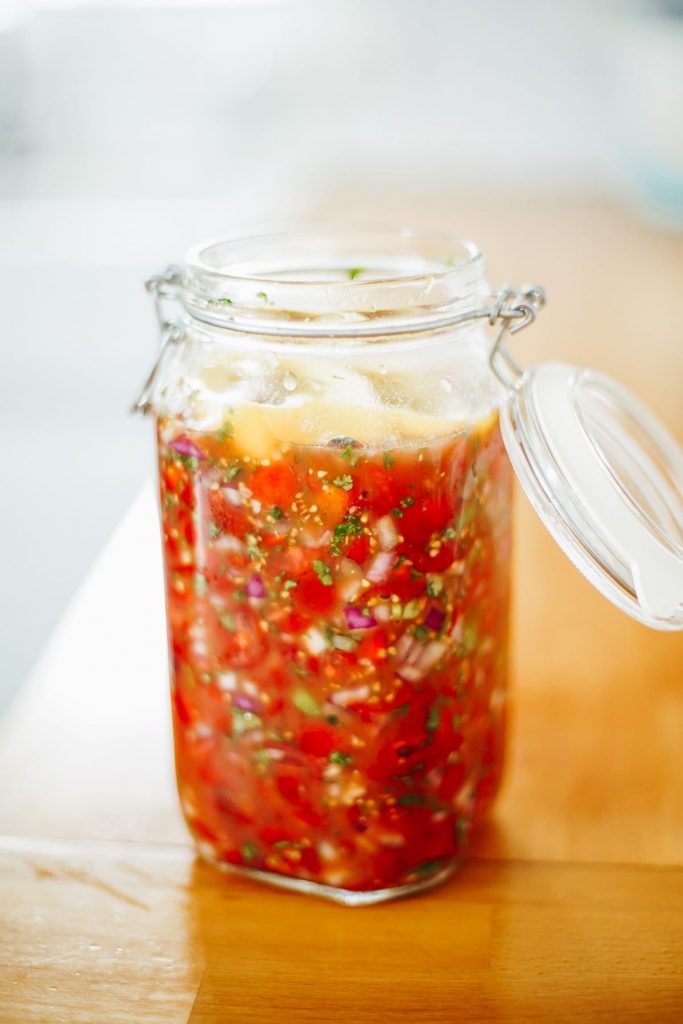
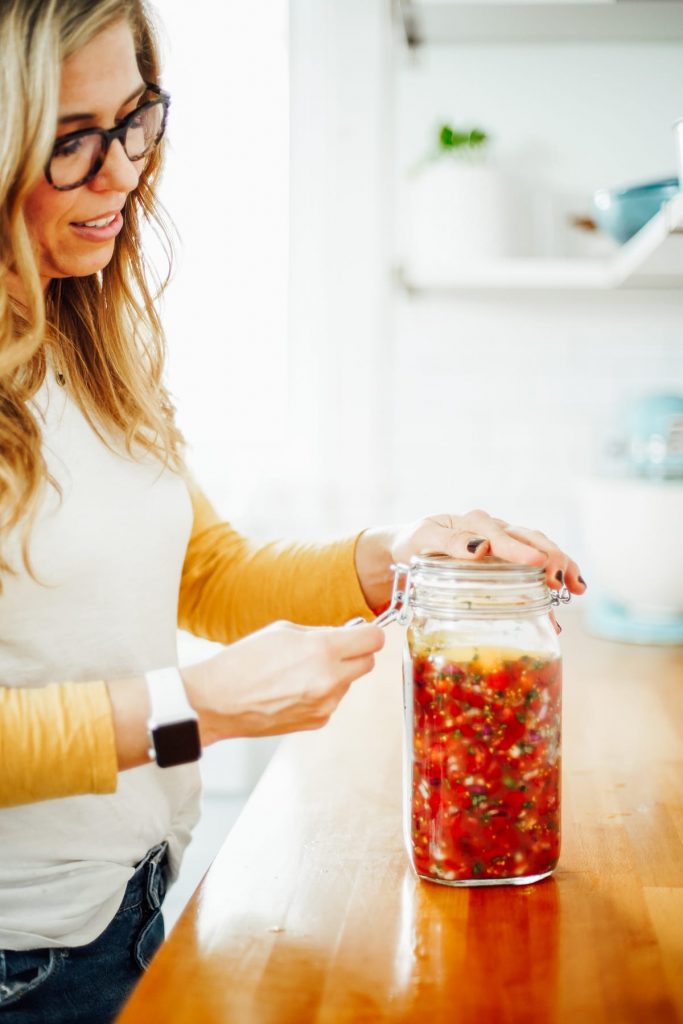
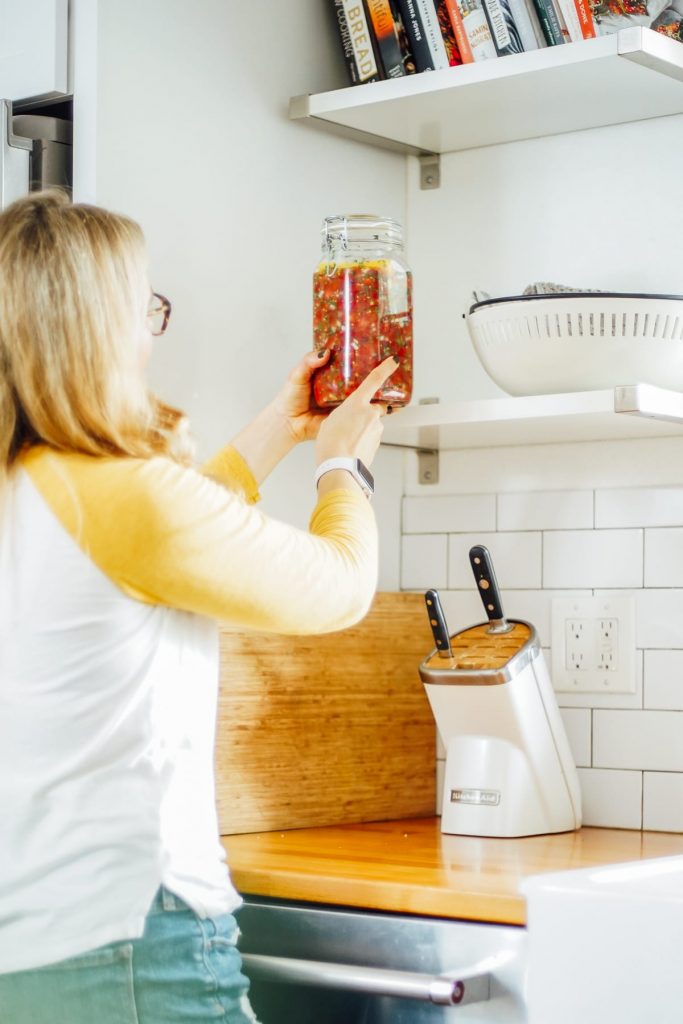

Step-by-Step Instructions
- Step 1 Combine the Vegetables, Salt, Lime Juice in a Bowl: Cut the tomatoes into small pieces, chop the onion and spicy pepper, mince the garlic, and chop the cilantro. Add the ingredients to a large bowl, along with lime juice and salt. Mix the ingredients together.
- Step 2 Add the Vegetables to the Fermentation Jar: Add the vegetables to a tall glass jar (whatever you’ll be using to ferment the salsa). Once you’ve added the salsa ingredients to the jar, add the juice/brine found at the bottom of the bowl to the jar. Push the salsa down with your hand (fist) to ensure the veggies are fully covered in the juice/brine. This takes some faith at first, because it doesn’t seem like there’s very much juice/brine compared to veggies. But, trust me, there’s enough juice/brine to cover the veggies.
- Step 3 Add a Weight to the Jar: Once the veggies are fully submerged in the brine, add a weight on top to keep the vegetables submerged in the liquid. You can use half of a bell pepper, a clean rock, a cabbage leaf: anything that will keep the veggies underneath the juice/brine.
- Step 4 Seal the Jar & Ferment For 2 Days: Tightly seal the jar and place in a spot that’s away from direct sunlight. Ferment the salsa at room temperature for 2 day (48 hours). You should notice, after about 24 hours, small bubbles begin to form in the salsa. This is part of the fermentation process as it comes “alive” and the beneficial bacteria works to ferment the vegetables. The bubbles won’t be super fizzy or aggressive, but should be apparent.
- Step 5 Enjoy & Store in the Fridge: After 2 days, the salsa is ready to enjoy. At this point, you can immeadiately open the jar and eat the salsa or store the salsa in the fridge. Either way, open the jar and remove the weight.
Food Safety Tips
- Cold Storage: After fermenting the vegetables on the counter, at room temperature, move the salsa to the fridge for long-term storage (fridge or root cellar work well). The salsa will keep for a couple of months. Once stored in a cold place, the fermentation process slows down, but the flavor will continue to develop.
- Mold Growth: This is a fast ferment, so there isn’t much time for mold growth to develop on top of the ferment (unlike sauerkraut which takes a couple of weeks). If mold growth occurs, it’s likely because the vegetables weren’t submerged in the salty brine. If fuzzy mold is only on top of the jar, the salsa should be okay. But never consume food where mold is present in the food. Listen to Sara from St Pete Ferment’s podcast all about fermentation for safety tips and concerns.
How to Store & Shelf Life
- Store the fermented salsa in the fridge, in an airtight container.
- The salsa will keep in the fridge for a couple of months.
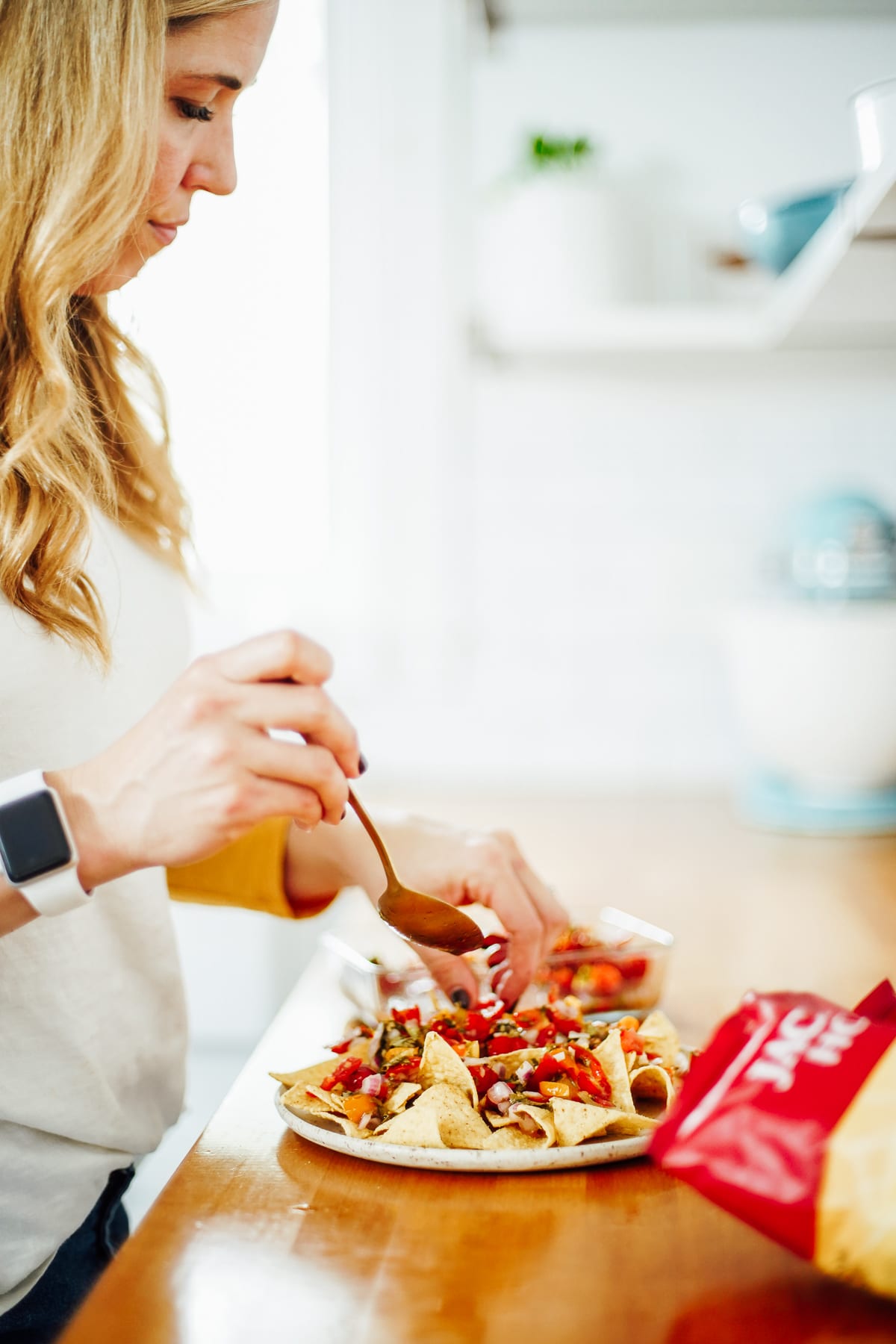
How to Serve & Enjoy
I can’t guarantee that your family will love fermented salsa, but I can say from experience that my family remains very apprehensive about fermented veggies but loves this recipe.
Sauerkraut, kimchi, or the fermented carrots that I purchase at market? Nope, they’re skeptics. Salsa, on the other hand, has been the key to introducing fermented veggies into their diet. Even Dustin, a picky eater when it comes to ferments, loves this salsa and asks for second and third helpings.
Here are a few of our favorite ways to enjoy this salsa…
- Perfect accompaniment to tortilla chips for snacking
- On top of homemade chicken nachos
- On top of ground beef tacos
- With sheet pan chicken fajitas
- On top of ground beef quesadillas
- on top of ground beef taquitos
- On top of homemade enchiladas
- In a school lunch with tortillas chips

Helpful Questions & Answers
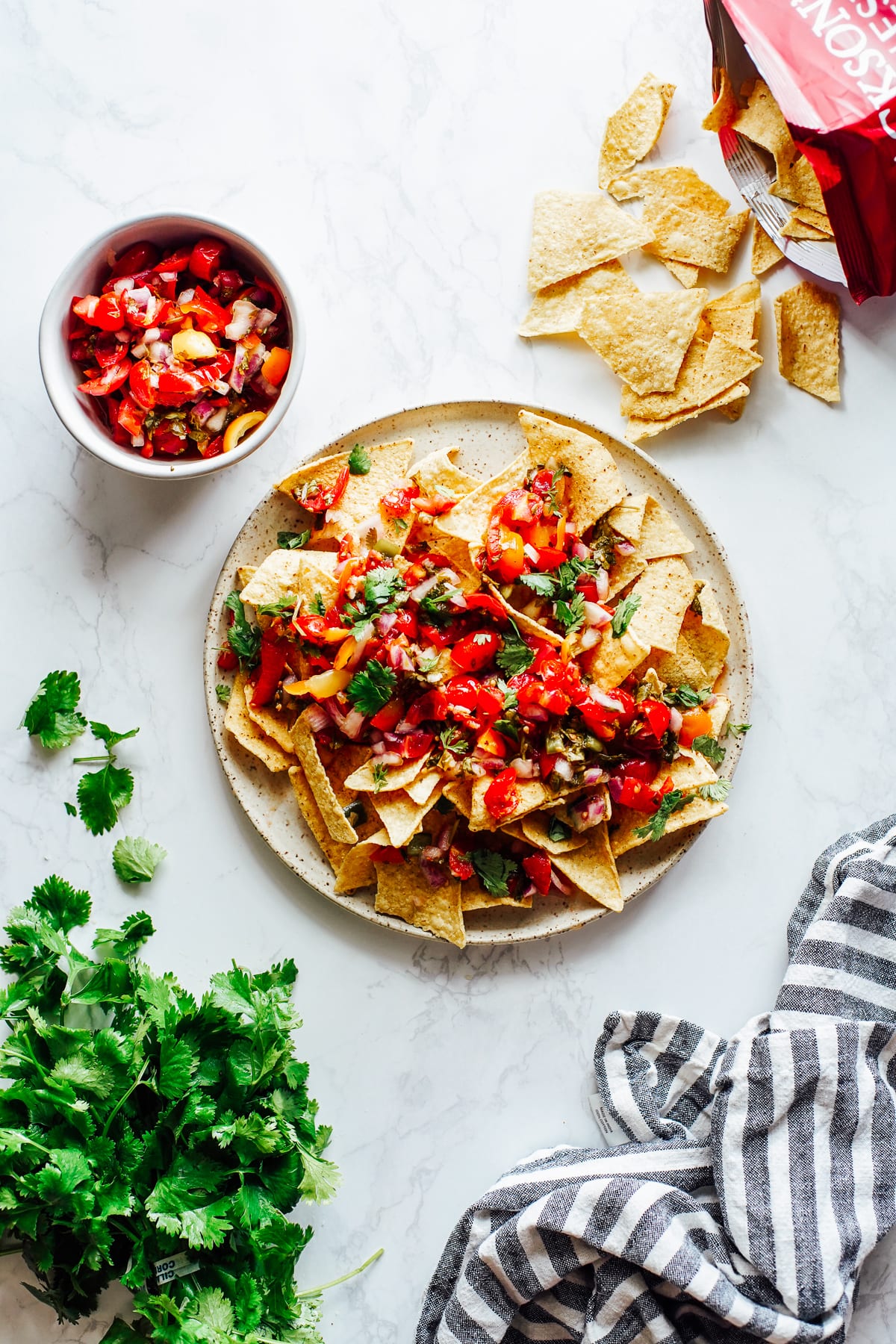
Why Ferment Salsa?
1. Fermented salsa tastes amazing
- Fermentation adds a deliciously tangy flavor to foods. That’s all thanks to the bacteria and natural yeasts at work.
- Fermentation takes cabbage, in the case of sauerkraut, and turns it into a slightly sweet and tangy food. It takes tea and sugar, in the case of kombucha, and makes a bubbly, slightly sour tea. In the case of salsa, fermentation offers a slightly tangy flavor that’s hard to resist.
2. Gut Health & Probiotics
- When you ferment fresh salsa, you end up with a bacteria-rich food. And do you know what thrives on good bacteria? Your gut (and immune system).
- Having a gut that’s healthy and thriving is important. This is why people take probiotic pills. And while I certainly think supplements have their time and place, I believe food should always be our #1 source when possible. Instead of instantly turning to a pill, we need to get back to consuming fermented foods, just like our ancestors did for thousands of years.
- An easy, natural, and budget-friendly way to populate your gut with good bacteria is to consume more fermented foods in your daily diet. This could include fermented cheese (real cheese, not a cheese product), yogurt, sauerkraut, salsa, kimchi, and kefir (make ranch dressing with kefir).
3. Fermentation preserves the salsa
- For thousands of years, people have fermented foods. Before refrigeration, fermentation played a major role in preserving a bountiful harvest (from the garden) or a large amount of milk (which would be turned into cheese).
- Fermentation encourages the growth of good bacteria so the bad bacteria doesn’t take over (causing food to spoil and rot).
- If you make regular salsa, it will likely go bad within a few days. When you ferment salsa, you extend the life of the salsa for up to a couple of months.
What Else Can You Ferment?
Once you make fermented salsa, and realize just how easy it is to make your own probiotic-rich, fermented foods, you may want to branch out and try making other ferments.
I’m still in the branching out phase. I’m slowly learning how to do more, and with each success my fermentation confidence grows. Here are a few ideas for what else you can ferment…
Fermented Recipes
- Yogurt: Make homemade yogurt in the slow-cooker or use the Instant Pot yogurt method.
- Ranch Dressing: Use fermented kefir (a dairy product) to make homemade ranch!
- Sourdough Bread: Of course, the most iconic of all fermented foods.
- Fermented Carrots: Next on my list to make. I love the fermented carrots found at the market (from St. Pete Ferments), now it’s time to make my own.
- Fermented Salsa Verde: Branch out from red salsa with this green salsa made with tomatillos.
- Ginger Bug: This is another ferment on my list to try.
- Kefir: One of the easiest ferments you can make. Use kefir to make smoothies (as all or just some of the liquid), yogurt sticks, or Ranch.
- Sauerkraut: A classic and so easy to make.
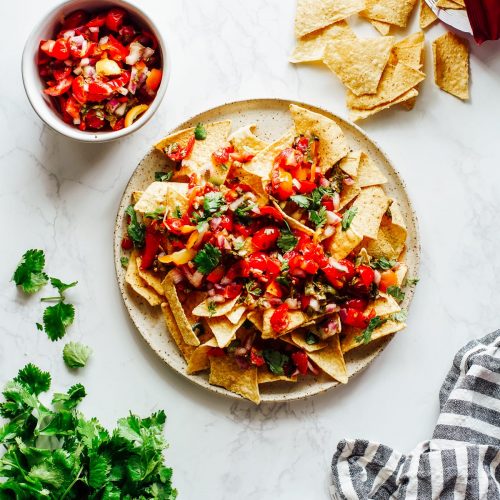
Fermented Salsa
Equipment
- 1 large bowl (for mixing the vegetables)
- 1 2-liter glass jar with an air-tight lid OR fermentation jar with lid (for fermenting the salsa)
- 1 weight such as: half a bell pepper, cabbage leaf, half an onion, a clean stone, or fermentation weight (to submerge the salsa in the liquid)
Ingredients
- 2 lbs cherry or grape tomatoes chopped
- 6 garlic cloves minced, or to taste
- 1-2 jalapeño pepper chopped, or a serrano pepper or poblano pepper
- 2 cilantro bunches chopped, just the leaves not the stems, depending on taste preference. I like a lot of cilantro. You could also skip the cilantro if desired.
- 1 medium red onion chopped (about 1-2 cups once chopped, depending on taste preference)
- 2 limes juiced
- 1 TB salt I use a fine salt (meaning the grind is fine, not coarse). Use a mineral-rich salt, like Redmond's Real Salt.
Instructions
- To a large bowl, add the chopped tomatoes, minced garlic cloves, jalapeño pepper, cilantro, red onion, lime juice, and salt. Toss to thoroughly combine.
- Taste the salsa. It should be salty, but not overpowering. If you can't taste the salt at all, add a few more pinches. You don't want a super salty salsa, but you should taste the salt. The salt is key in aiding the fermentation process and keeping the "bad bacteria" from populating. I usually add a bit more salt, after the initial 1 tablespoon. Use your sense of taste as your guide.
- Add the salsa to an air-tight glass jar. I use a 2 liter jar from Fido (pictured in this post). Ball Jars also work well. You may also divide the mixture between two jars, if needed.
- Once all the salsa is added to the jar, add the brine/juice left at the bottom of the bowl to the jar.
- Press the salsa down in the jar so the veggies are fully submerged in the juice/brine. Then add your weight of choice. I've been using half a bell pepper as a weight. This is used to keep the veggies fully submerged in the juice/brine. The weight, if perishable, will be tossed at the end of the fermentation process (unless you're using a stone).
- Tightly seal the jar and place in a spot that's away from direct sunlight. Ferment the salsa at room temperature for 2 day (48 hours). You should notice, after about 24 hours, that bubbles begin to form in the salsa. This is part of the fermentation process as it comes "alive." The bubbles won't be super fizzy or aggressive, but should be apparent.
- After 2 days, your salsa is ready to enjoy. At this point, you can immeadiately open the jar and eat the salsa or store the salsa in the fridge (it will keep for a couple of months). Either way, open the jar and remove the weight. If you choose to store the salsa in the fridge, the fermentation process slows down, but the flavor will continue to develop so keep this in mind.
- Use this salsa just like any fresh salsa: topped on quesadillas, taquitos, or enchiladas, in tacos, with tortilla chips, etc.
Notes
- we go through this salsa quickly
- it does take some time to chop the veggies and I want to use my time wisely (making enough to last multiple snacks and meals)
- it keeps in the fridge for a couple of months, so there’s no need to use it up super fast
Nutrition
TAKE THE STRESS OUT OF HEALTHY MEALS
Free Weekly Meal Plan
Healthy recipes and time-saving strategies that make meal time easier. Join 15,000 families who are simplifying meals with my weekly meal plan.



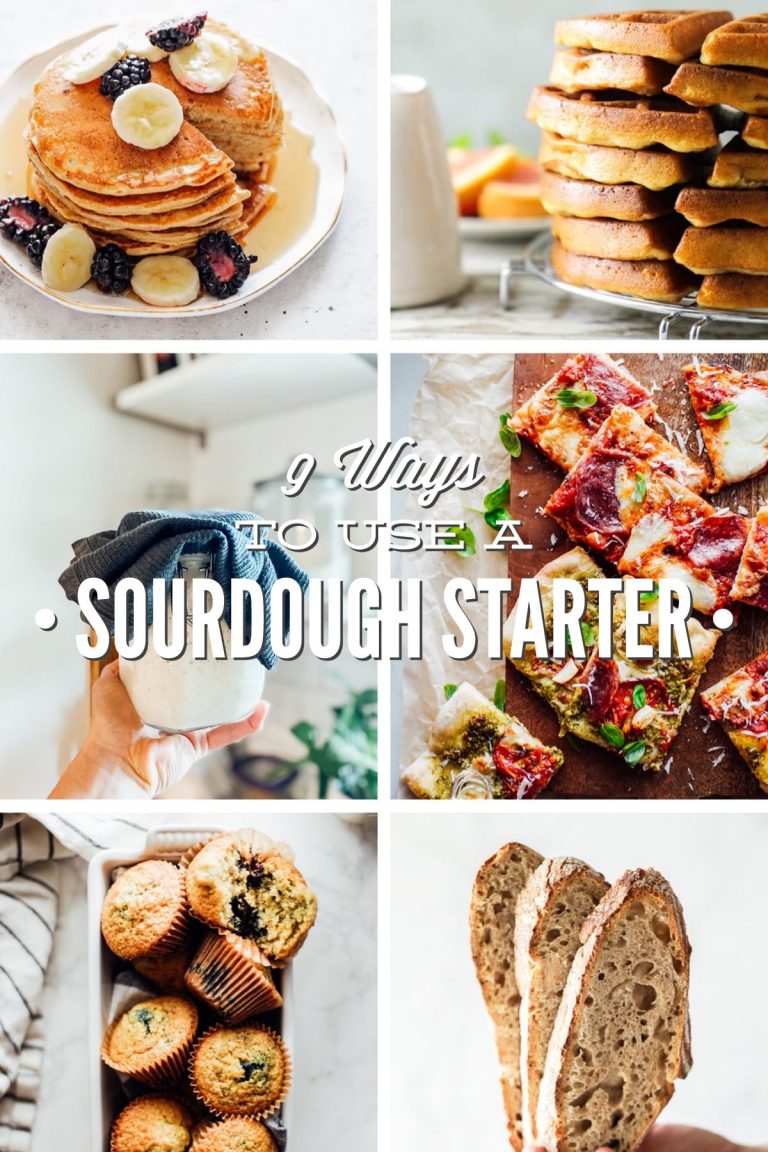

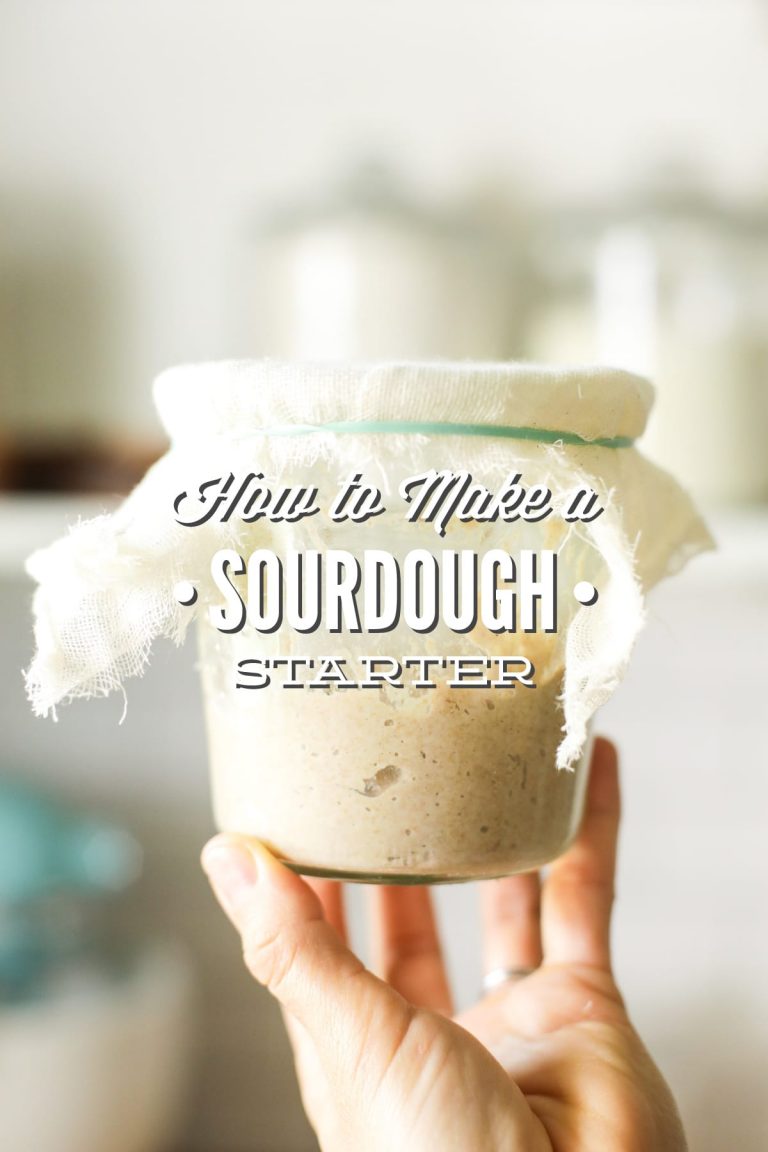
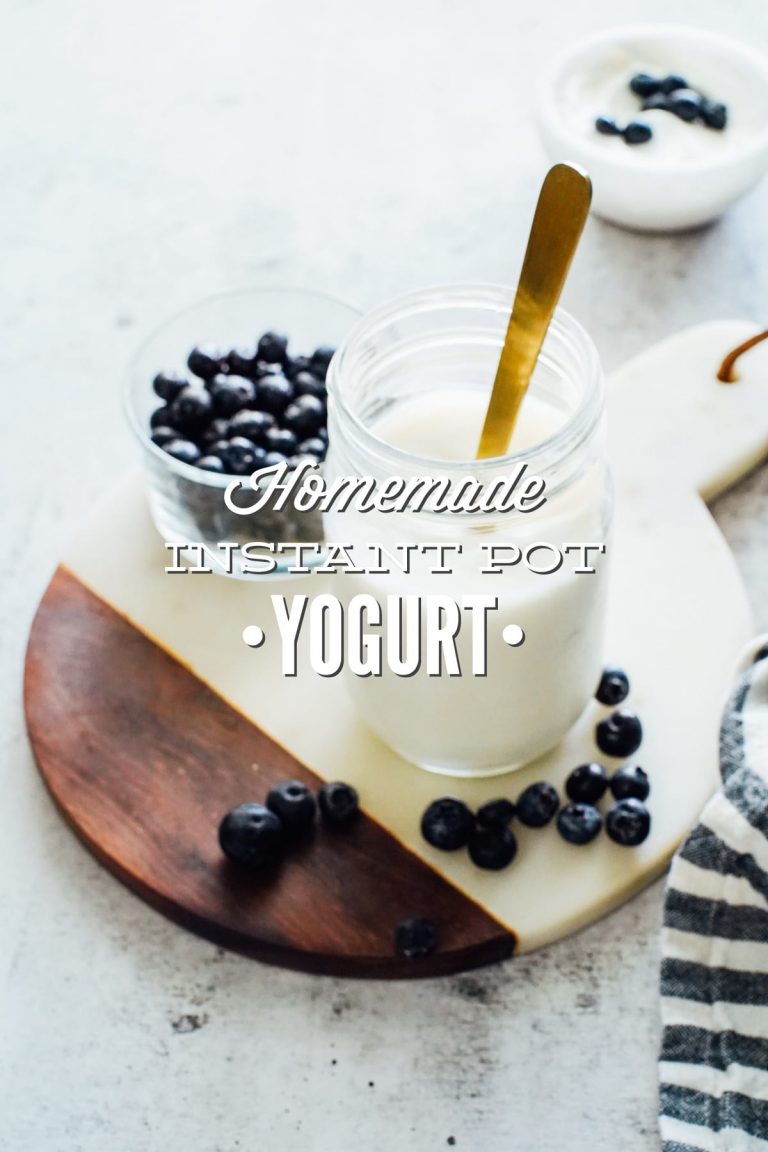
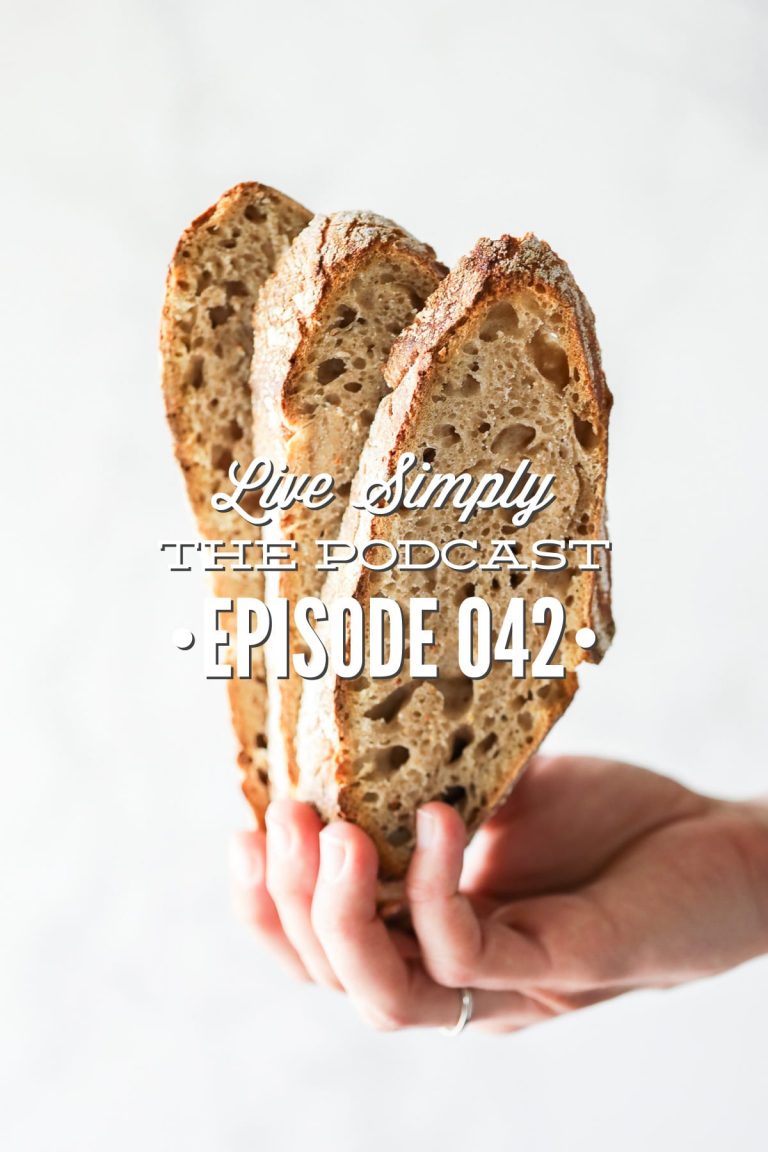
Hi Kristen!
Can you please provide the full nutritional information for this? Thank you!
Hi Angela, what exactly are you looking for? We can try and provide what for you.
LS Team
Hi there! My family is absolutely obsessed with this recipe? Have you tried canning it? I’d like to make larger batches but don’t have the refrigerator space
Hey Monika, So glad you love the salsa. The beauty of fermentation is that it preserves the food without the need for canning. Since fermentation deals with raw food, the processing from canning will cause the food to lose the benefits of such food. The salsa will keep in the fridge for many months–as fermentation naturally preserves the food. So you could make a large batch and store in the fridge.
I want to try this, but am concerned that one jalapeno for 2 lbs of tomatoes might not be spicy enough. We generally like things with a medium amount of heat. I know that the hot peppers I grow vary widely in heat level though, so I don’t want to add too many! Do you think 3 would be too hot? Does the fermentation decrease the heat level like pickling does? Thanks
Hi Christina,
Definitely try. The process will decrease the heat.
LS Team
Good morning! This recipe looks great. I’m wondering…In the past, I’ve made fermented salsa with a bit of leftover whey from my homemade yogurt. Could I add this to help in the fermentation process? Would I lessen the salt perhaps?
Hey Rachel, You could, not sure about the salt amount when adding whey.
Is it safe to use the stems of cilantro? We love cilantro and lots of it!
HELP please – I followed directions and now at 48 hours there isn’t a bubble to be seen. I have fremented before and know the bubbles should be apparent by now. I can’t understand why they aren’t. Should I add more salt, throw it out, or eat it?
Hey Mara, The bubbles will not be super active or bubbly, but they should be apparent throughout the salsa. Do you see any air pockets (bubbles) in the salsa mixture? If so, you’re good. You can taste the salsa and if you like it, then you can stick it in the fridge and enjoy. If you want to go another day or two, you can do that. The salsa will continue to ferment in the fridge, it just slows the process down. Adding more salt will SLOW the fermentation process down. I made an Instagram Live video showing the entire process and what to look for. You may find it helpful: https://www.instagram.com/tv/CAlZedNpOHO/?utm_source=ig_web_copy_link
Hi Kristin,
I cleaned out the last of my COVID garden, frost tonight. I am playing with fermenting and this is my second venture. I liked your recipe and it is similar to what I normal use to can Salsa. I did not have limes, but my old recipe used cider vinegar. Without thinking, I dumped some in with the other ingredients. Have I ruined it with the vinegar? Almost 5# of vegetables and 1/2 cup cider vinegar.
I hope you can let me know. If I have ruined it, maybe I can salvage all those veggies. Thanks so much!
Hi Cathy, I think vinegar will be just fine!
LS Team
I have some whole frozen tomatoes in my freezer from last year’s harvest & was wondering if they can be thawed & used to ferment a “runny” salsa?
Hey Melinda, That’s a good question. I’m not sure. If they haven’t been cooked, that may work. If they have been cooked, they I don’t think they’ll work for this. I would google using frozen produce for ferments and see what comes up.
Love this salsa! My husband was skeptical initially but he loves it! We make it all the time now.
That’s amazing, Jamie! Thank you so much for sharing and rating the salsa.
I have some pico de gallo that I made with these same veggies, however I also added some dried spices. I put it together 4 days ago… do you think I could take it out of the fridge and try to ferment it at this point? Or should I start fresh?
Hey Hannah, I would start fresh, just to be safe. You could definitely use dried spices in the next batch when you ferment it.
Sounds good! Can’t wait to try it!
I started chopping veggies for salsa a few days ago, but got interrupted by other jobs/kids; I put my bowl of veggies, dried chilies and canning salt in the fridge with the intent of getting back to it later in the day… now a few days later in my search to see if it’s still possible to use or if I need to throw it out, I came across your recipe… since I put salt in it, can I add lime and do fermentation, or do I also need to start fresh? Thanks!
Hey Tanis, I’m not quite sure, but I personally would play it safe and start over.
Have you ever put these in a blender to make it more saucy yet chunky? In Texas we would call your recipe more like pico de gallo vs a runny mixture called salsa.
Hey Brenda, Yes, you can do that. It can speed up the fermentation process, so just keep an eye on the salsa. Blend all the ingredients in the blender and then add the salt and ferment.
I like a more runny salsa as well versus pico. When you say that it could speed up the fermentation and to keep an eye on it, what exactly would I be looking for? I have never fermented anything so I am not exactly sure what to look for.
Hey Penny, You’ll notice air pockets begin to form in the salsa. I just made a batch last night, and blended it up versus making a thick salsa (pico). Today, the air pockets are very noticeable versus the thick (pico) salsa usually take a bit longer for the air pockets to begin to form. The air pockets are a sign fermentation is taking place. So, I may only ferment this salsa for 24-36 hours versus the full 48 hours. There’s nothing wrong with going longer, but it may be more tangy. It’s perfectly safe to go the full 48 hours or longer. Also, when you blend, just make sure everything is submerged in the liquid, and separation may occur in the jar. That’s normal and perfectly fine.
So excited to make this today and love all of your recipes! Do you keep all the seeds from the jalapeno? Does the 1 jalapeno make it mildly spicy?
Hey Laura, Thank you. I recommend removing the seeds, particularly if you don’t want a spicy salsa. It will depend on the jalapeno. Some jalapenos have no heat while others do. Enjoy!!
I love peaches with salsa, do you think is would work with added fresh peaches?
Hey Kristine, Hmmm, possibly. The sugar in the peaches may increase the fermentation process. Not sure.
One more question 😉 Can I add red peppers too…and if yes how many could I add? Thank you.
Hey Sandy, Definitely. Not sure how many–just go based on taste.
I am using tomatoes from my garden and am not sure what 2 lbs looks like. Do you know how many cups approximately that would be? Thanks!
Hey Sandy, I’m not sure since tomatoes can vary in size so much. It will depend on size and what kind of tomatoes you’re using.
Make sure to make a HUGE batch because you’ll be eating a ton. Its AMAZING!
Hi there! This smells and tastes amazing. One question, when I made it there was not quite enough liquid so I added a little water, just enough to submerge. Could that affect the balance in the fermentation? I didn’t see many bubbles and wondered if that was why. Taste was still great and now I’ve put it in the fridge. Thanks for all you do!
Hey Tami, The bubbles are more air pockets forming in the salsa than actual bubbling action. There shouldn’t be an aggressive bubbly with this ferment. Once you’ve really squished down the salsa in the jar, if there isn’t any liquid to submerge the salsa, you can add water, that’s fine, or add more lime juice.
Update: sent the salsa with my husband’s lunch and got a text saying salsa is delicious, we should never buy salsa again!
The reason I only gave 4 stars is that I made 1/2 recipe and used a whole jalapeno pepper, but there was no heat at all. Maybe I need to add more, or maybe I just got a dud. Either way, the salsa itself is delicious!
That’s amazing, Sarah!!! Yay, so happy to hear that. Yea, jalapenos can vary greatly in heat. Many just aren’t hot these days. Next time, go with a serrano. Or, add a couple of serrano peppers.
This is way past when you posted, but just for others’ general info, I’m pretty sure I’ve read that jalapeños lose some of their bite when they’re fermented. Maybe a little fresh jalapeño (not fermented) added at serving time wouldn’t hurt,
Ooo, that’s good info, Judy. Thank you for sharing. Good idea.
sometimes jalapenos vary in heat so try a piece fresh to determine heat
Made this tonight so I can’t comment on final outcome yet, but just wanted to share a tip. We prefer our salsa a little less chunky, so I used a food processor to chop the veggies finely. Worked great, and way faster then fine chopping by hand! I did each veggie separately, scraping the chopped veggies into a bowl in between, being careful to get all the liquid.
That’s perfect, Sarah! Thank you for sharing. The salsa may ferment a bit faster, so it may be ready before the 48 hour mark.
Thank you Kristin for this recipe! For our family I will add less onion next time or maybe instead of using a red onion like I did maybe I will use a sweet onion. I used a large jalapeno and when I tasted the salsa fresh, before fermenting, I thought I had gotten it too hot for my grand-kids, but after fermentation it was not as hot. I also thought I might add a bit less cilantro to the batch and then add some fresh when served. Even though I have made fermented foods before, I was skeptical that fermented salsa would last that long, but it is still delicious and like you said, the flavors continue to develop. This is a recipe that will be used over and over for our family. Thank you!
I get an abundance of heirloom tomatoes in my CSA box, this would be perfect to use them up. How do you think they would do compared to cherry/grape tomatoes?
Hey Tamara, Those should work great!